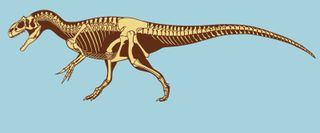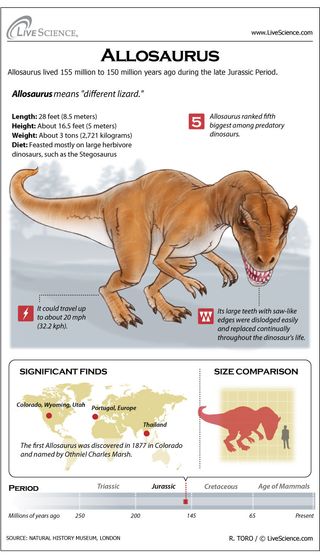Allosaurus: Facts About the 'Different Lizard'

Allosaurus was among the earliest dinosaur discoveries, and fossils are plentiful, making it a darling of paleontologists, as well as amateur dinosaur observers.
This large theropod (bipedal, carnivorous dinosaur), which is Utah's state fossil, lived 155.7 million to 150.8 million years ago during the late Jurassic Period. Allosaurus is the most common dinosaur fossil found in Utah's Cleveland-Lloyd Quarry, a site containing the densest concentration of Jurassic dinosaur bones in the world. Of the at least 74 individual dinosaurs found at the quarry, about 46 of them are Allosaurus specimens, according to the U.S. Bureau of Land Management. The bulk of Allosaurus fossils found to date, however, come from the Morrison Formation, which is centered in Wyoming and Colorado.
Fossils possibly belonging to Allosaurus have also been discovered in several other places around the globe, including Portugal, Siberia and Tanzania.
The name Allosaurus is derived from the Greek allos ("different" or "other") and sauros ("lizard"). It was so-named because its vertebrae were different from any other dinosaur known at the time of its discovery in 1877. Specifically, some of the vertebrae of Allosaurus fragilis (Latin for "fragile") were concave on both sides and contained shallow cavities, giving them an hourglass shape — these features reduced the bones' strength, while making them lighter. The hollow spaces in these neck and anterior back vertebrae are also found in modern birds and believed to have contained air sacs for respiration.
Aside from A. fragilis, it's unclear how many other Allosaurus species existed — up to eight different species have been proposed in last 30 years. "Allosaurids from the Late Jurassic Morrison Formation are lumped into a singular genus with [a] couple of species," said paleontologist Matthew Mossbrucker, director and chief curator at the Morrison Natural History Museum. "But the reality of the diversity of these animals is under-recognized."
Only a handful of species is considered valid at any one time, though just which species are valid is still debated. Currently, there are four "unambiguous" North American Allosaurus species (A. fragilis, A. atrox, A. jimmadseni and A. lucasi), according to a 2014 study in the journal Volumina Jurassica.
In any case, Allosaurus was a massive carnivore. The largest specimens may have rivaled T. rex in size, growing up to 39 to 43 feet (12 to 13 meters) long and 15 to 16 feet (4.5 to 5 meters) tall, according to a 1976 analysis of A. fragilis in the Utah Geological Survey Bulletin. Weight estimates of Allosaurus vary, but models of the famous A. fragilis specimen "Big Al" suggest the dinosaur weighed more than 3,300 pounds (1,500 kilograms) in adulthood, according to a 2009 study in the journal Palaeontologia Electronica.

Allosaurus likely attained its full adult size by age 15 and lived up to 28 years old, a 2006 study in the Journal of Morphology found.
Allosaurus had a short neck and a narrow, elongated skull, which was disproportionately large, similar to those of other big carnivorous theropods. But unlike other theropods, it had a pair of small horns above its eyes, which were extensions of the lacrimal bones in the skull. It also had ridges that ran along the top of the nasal bones to the horns.
The dinosaur's mouth contained dozens of sharp teeth that were serrated at the front and rear edges. The bones that formed the tip of the snout (the premaxilla) held five teeth, while the main tooth-bearing bones of the upper jaw (the maxilla) and the tooth-bearing bones of the lower jaw (the dentary) held between 14 and 17 teeth each. The teeth were likely easily lost during feeding and rapidly (and continuously) replaced, according to the 1976 analysis.
Allosaurus' massive body was supported by two powerful hind limbs and a large tail. Each foot had three weight-bearing toes and an inner dewclaw. Models suggest Allosaurus could run up to 21 mph (33.8 kph), according to a 2007 study in the journal Proceedings of the Royal Society B.
What did Allosaurus eat?
Allosaurus feasted mostly on large herbivore dinosaurs, and paleontologists have long thought the dinosaur tussled with Stegosaurus. In 1914, paleontologist C. W. Gilmore described three Stegosaurus tail spikes that broke or became malformed during the dinosaur's life, suggesting it whacked other dinosaurs hard enough to break its spikes, Mossbrucker told Live Science. "Hate to see what the other dinosaur would look like after the spike-busting strike."
More recently, researchers have unearthed more direct evidence of these epic battles. For instance, paleontologists have found an Allosaurus tail vertebra with a puncture wound that matches the shape of a Stegosaurus tail spike, and a Stegosaurus neck bone bearing a U-shaped bite mark that corresponds to the shape of Allosaurus jaws, according to a paper published in The Carnivorous Dinosaurs (Indiana University Press, 2005).
At the 2014 annual meeting of the Geological Society of America, Mossbrucker and his colleagues reported an allosaur pelvis bone stab wound that was in the conical shape of a stegosaur tail spike. The bone showed no evidence of healing, suggesting the stab wound was fatal to the carnivore, Mossbrucker said.
Allosaurus was capable of killing healthy medium-sized sauropods (long-necked herbivores) or large sauropods, such as Apatosaurus, that were sick or injured. It was a fierce and aggressive predator, as indicated by the tooth marks discovered on the vertebrae of an Apatosaurus. The dinosaur may have been able to take on a healthy, fully grown Apatosaurus if it hunted in packs, though it's debated whether the dinosaurs could cooperate in this fashion (they may have been aggressive towards each other).
Like T. rex and other large carnivores, Allosaurus probably scavenged as well as hunted. "The whole idea of 'pure predators' versus 'pure scavengers' is contradicted by the reality of ecology," Mossbrucker said. "Today, all apex carnivores are opportunistic — they simply consume the protein most available to them at any given time."
Despite its large skull, Allosaurus had a bite that was weaker than alligators, lions and leopards, a 2001 study in the journal Nature found. Because of this, some researchers believe the dinosaur may have used its skull as a hatchet, slamming its upper jaws into its prey and then tearing out flesh with its slashing teeth.

A 2013 study in the journal Palaeontologia Electronica found the dinosaur was capable of the head and neck movements necessary for this type of feeding, and further suggested that Allosaurusstripped meat from carcasses by pulling its head straight up and back, similar to the way small falcons feed.
Fossil finds
The first Allosaurus was discovered in 1877 in Colorado and named by Othniel Charles Marsh. This specimen offered just a few fragments of the dinosaur. Marsh went on to name other, seemingly unique dinosaur specimens, which, with time, were discovered to also be Allosaurus fossils, causing quite a bit of confusion in the early documentation of this dinosaur.
A more complete Allosaurus skeleton was discovered in 1879 by H.F. Hubbell, but was left unpacked at the time. In 1903, after Hubbell's death, the specimen was finally examined and turned out to be one of the most complete theropod skeletons unearthed to date.
In 1991, a joint team consisting of researchers from the Museum of the Rockies and the University of Wyoming Geological Museum found an Allosaurus fossil near Shell, Wyo. that was 95 percent intact — they dubbed it "Big Al." In 1996, the same team discovered "Big Al Two," the best-preserved Allosaurus skeleton to date.
Additional reporting by Kim Ann Zimmermann, Live Science Contributor
Related pages
More dinosaurs
- Allosaurus: Facts About the 'Different Lizard'
- Ankylosaurus: Facts About the Armored Dinosaur
- Apatosaurus: Facts About the 'Deceptive Lizard'
- Archaeopteryx: Facts about the Transitional Fossil
- Brachiosaurus: Facts About the Giraffe-like Dinosaur
- Diplodocus: Facts About the Longest Dinosaur
- Giganotosaurus: Facts about the 'Giant Southern Lizard'
- Pterodactyl, Pteranodon & Other Flying 'Dinosaurs'
- Spinosaurus: The Largest Carnivorous Dinosaur
- Stegosaurus: Bony Plates & Tiny Brain
- Triceratops: Facts about the Three-horned Dinosaur
- Tyrannosaurus Rex: Facts about T. Rex, King of the Dinosaurs
- Velociraptor: Facts about the 'Speedy Thief'
Time periods
Precambrian: Facts About the Beginning of Time
Paleozoic Era: Facts & Information
- Cambrian Period: Facts & Information
- Silurian Period Facts: Climate, Animals & Plants
- Devonian Period: Climate, Animals & Plants
- Permian Period: Climate, Animals & Plants
Mesozoic Era: Age of the Dinosaurs
- Triassic Period Facts: Climate, Animals & Plants
- Jurassic Period Facts
- Cretaceous Period: Facts About Animals, Plants & Climate
Cenozoic Era: Facts About Climate, Animals & Plants
Additional resources
- Animation featuring Allosaurus can be found at the BBC's Nature.
- Utah's state fossil is featured at the Natural History Museum of Utah.
- According to the Dinosaur National Monument, the Allosaurus fragilis skeleton found there has one of the best skulls of any late Jurassic predatory dinosaur in the world!
Sign up for the Live Science daily newsletter now
Get the world’s most fascinating discoveries delivered straight to your inbox.

